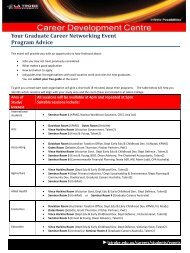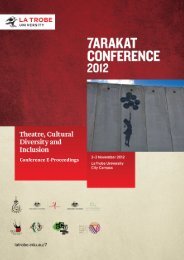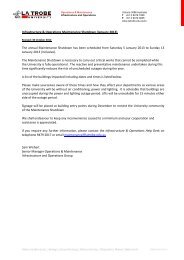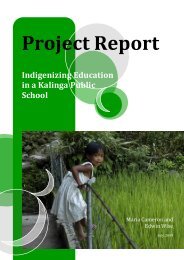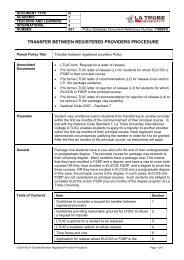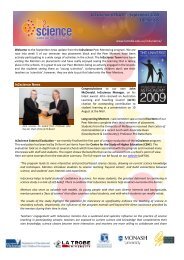Astride a long-dead horse. Mainstream outdoor education theory ...
Astride a long-dead horse. Mainstream outdoor education theory ...
Astride a long-dead horse. Mainstream outdoor education theory ...
You also want an ePaper? Increase the reach of your titles
YUMPU automatically turns print PDFs into web optimized ePapers that Google loves.
<strong>Astride</strong> a <strong>long</strong>-<strong>dead</strong> <strong>horse</strong>. <strong>Mainstream</strong> <strong>outdoor</strong> <strong>education</strong> <strong>theory</strong> and the central<br />
curriculum problem<br />
Abstract<br />
In 1859 Herbert Spencer recognised that the key curriculum issue was not what to include but<br />
what to leave out. “What to leave out” marked a shift in curriculum discourse from a search<br />
for universal approaches and absolute principles towards curriculum questions understood as<br />
only resolvable relative to particular social contexts. Yet <strong>outdoor</strong> <strong>education</strong> is frequently<br />
explained and justified in universal, absolute terms that are incapable of resolving the<br />
question of <strong>outdoor</strong> <strong>education</strong>’s <strong>education</strong>al worth in any particular situation. The first part of<br />
this study outlines some necessary links between curriculum discourse and <strong>outdoor</strong> <strong>education</strong><br />
<strong>theory</strong>. The second uses <strong>outdoor</strong> <strong>education</strong> textbooks to investigate how context-free<br />
rationales for <strong>outdoor</strong> <strong>education</strong> have been framed. It found textbooks used one or more<br />
rhetorical devices: (1) treating <strong>education</strong> as personal development, with only limited<br />
acknowledgment of the social functions and contexts of <strong>education</strong> (2) omitting the <strong>outdoor</strong>s<br />
from aims and purposes, or treating the <strong>outdoor</strong>s as monolithic, and (3) describing aims and<br />
purposes in broad and abstract terms. Adopting any or all of these positions drastically<br />
reduced the capacities of the proffered theories to (a) help determine if any given program<br />
was necessary or (b) help determine what programs were necessary. The article concludes<br />
that the evident flaws in textbooks indicate a more widespread failure in the <strong>outdoor</strong><br />
<strong>education</strong> literature to comprehend curriculum questions.<br />
Brookes, A. (2004). <strong>Astride</strong> a <strong>long</strong>-<strong>dead</strong> <strong>horse</strong>. <strong>Mainstream</strong> <strong>outdoor</strong> <strong>education</strong> <strong>theory</strong><br />
and the central curriculum problem. Australian Journal of Outdoor Education, 8(2), 22-<br />
33.
<strong>Astride</strong> a <strong>long</strong>-<strong>dead</strong> <strong>horse</strong>. <strong>Mainstream</strong> <strong>outdoor</strong> <strong>education</strong> <strong>theory</strong> and the<br />
central curriculum problem.<br />
Introduction<br />
In what circumstances and on what grounds might <strong>outdoor</strong> <strong>education</strong> be dispensed with?<br />
Undoubtedly all kinds of <strong>education</strong>al aims and purposes may be linked plausibly to <strong>outdoor</strong><br />
<strong>education</strong>, and some <strong>education</strong>al benefits may seem obvious. Numerous contributions to the<br />
<strong>outdoor</strong> <strong>education</strong> literature that consider processes of teaching and learning in the <strong>outdoor</strong>s<br />
also consider possible aims and purposes. However, the question of whether or not <strong>outdoor</strong><br />
experiences can or do uniquely fulfil any essential <strong>education</strong>al purpose is often treated<br />
relatively lightly. Is <strong>outdoor</strong> <strong>education</strong> the best approach to solving certain <strong>education</strong>al<br />
problems? Does it offer any exclusive <strong>education</strong>al benefits, and if so, should those benefits be<br />
preferred ahead of other possibilities? While a tendency to shy away from these more<br />
difficult questions is not ubiquitous in the <strong>outdoor</strong> <strong>education</strong> literature, I have frequently<br />
encountered it. In contrast, the question of what to leave out is central to curriculum studies,<br />
the area of <strong>education</strong>al thought concerned with the aims and purposes of <strong>education</strong><br />
(Hamilton, 1990). In this study I explore the relationship – or lack of it, as the case may be –<br />
between <strong>outdoor</strong> <strong>education</strong> discourse and curriculum discourse, and consider what evidence<br />
there may be that <strong>outdoor</strong> <strong>education</strong> <strong>theory</strong> and research has failed to properly consider the<br />
grounds on which <strong>outdoor</strong> <strong>education</strong> could be justified <strong>education</strong>ally.<br />
Outdoor <strong>education</strong> discourse need not necessarily be concerned with the question of<br />
indispensability, of course. It is not chiselled in granite that <strong>outdoor</strong> <strong>education</strong> achieve unique<br />
<strong>education</strong>al benefits , although recognising <strong>outdoor</strong> <strong>education</strong> as just one of several<br />
alternatives may lend more circumspection to the promotion of <strong>outdoor</strong> <strong>education</strong> programs.<br />
Nor is it written that all <strong>outdoor</strong> <strong>education</strong> research and scholarship be concerned with the<br />
significance of the field in a wider context – <strong>outdoor</strong> <strong>education</strong> exists, and there is work to do<br />
in explaining and improving it. It is conceivable that providers and participants alike support<br />
some <strong>outdoor</strong> <strong>education</strong> programs, whose <strong>education</strong>al aims and purposes are not unique,<br />
because to do so suits their interests and inclinations – <strong>education</strong> often takes a particular form<br />
for non-<strong>education</strong>al reasons. The more grandiose the <strong>education</strong>al claims for <strong>outdoor</strong><br />
<strong>education</strong>, the more one might suspect the real reasons for the program lie elsewhere, but that<br />
is not to say those non-<strong>education</strong>al reasons should be summarily dismissed. Nevertheless it
seems reasonable to expect that <strong>outdoor</strong> <strong>education</strong> <strong>theory</strong> be capable of helping to distinguish<br />
between circumstances in which <strong>outdoor</strong> <strong>education</strong>, in some form, is necessary, and<br />
circumstances in which <strong>outdoor</strong> <strong>education</strong> is possible but not necessary.<br />
This study is a step towards making some stronger connections between <strong>outdoor</strong> <strong>education</strong><br />
<strong>theory</strong> and curriculum studies. As a study of some texts – their origins, meanings, uses, and<br />
logic – I have been drawn more to humanities research traditions (history, literature, cultural<br />
studies and philosophy, respectively), than to the social science methods that are more<br />
common in the <strong>outdoor</strong> field. As befits a humanities approach, I have incorporated details of<br />
my methods into the body of the text. Much of the article is devoted to the problem of linking<br />
two largely separate discourses, and to outlining some key elements of curriculum study. In<br />
particular, I explain why curriculum practices and principles are necessarily circumstantial,<br />
and why universalist or absolutist approaches to <strong>outdoor</strong> <strong>education</strong> must be seen, from a<br />
curriculum perspective, as astride a <strong>long</strong>-<strong>dead</strong> <strong>horse</strong>. I conclude the paper with a study of<br />
several <strong>outdoor</strong> <strong>education</strong> textbooks. My interest was not in textbooks as such; rather, I used<br />
textbooks – those to hand which considered the question of aims and purposes – as a<br />
convenient way to obtain some snapshots of the means by which <strong>outdoor</strong> <strong>education</strong> <strong>theory</strong><br />
has failed, on a basic level, to provide a framework from which <strong>outdoor</strong> <strong>education</strong> could be<br />
justified as <strong>education</strong>. Clearly the failure is substantial and extensive. How extensive remains<br />
a question for further study.<br />
Curriculum discourse and <strong>outdoor</strong> <strong>education</strong> discourse<br />
It is only necessary to skim the contemporary <strong>outdoor</strong> <strong>education</strong> literature to see that it<br />
contains multiple discourses, parallel conversations which, even on a close reading,<br />
sometimes seem to have little in common. To the extent that nearly all contributions to the<br />
literature purport to be about <strong>outdoor</strong> <strong>education</strong>, these different strands can seem at crosspurposes.<br />
Given that all of the major <strong>outdoor</strong> <strong>education</strong> scholarly journals were originally the<br />
organs of professional organizations comprised of <strong>outdoor</strong> guides, teachers, skills instructors,<br />
camp operators, corporate trainers, youth workers and others, these differences are hardly<br />
surprising, especially when the different interests of academics, researchers, practitioners and<br />
administrators are added to the mix. Textbooks or literature reviews sometimes exaggerate
the importance of <strong>outdoor</strong> <strong>education</strong>, tidy up the discourse and ignore or downplay<br />
contradictions, but this too is not surprising. Most texts impose structure on their subject<br />
matter to some extent, this article included. Moreover, professional groups with one eye on<br />
their own interests and the other on the public interest dissemble as a matter of course.<br />
Many contributions to the <strong>outdoor</strong> <strong>education</strong> literature are plainly aimed at an audience who<br />
work within the <strong>outdoor</strong> <strong>education</strong> field. For example, Hovelynck and Peeters (2003) discuss<br />
the role of humour in ‘learning and facilitating’. They draw on literature from outside the<br />
<strong>outdoor</strong> <strong>education</strong> field, and present some examples of humour within <strong>outdoor</strong> therapy<br />
sessions to illustrate points drawn from the wider literature. The article makes no attempt to<br />
argue that <strong>outdoor</strong> <strong>education</strong> humour is distinctive, nor that <strong>outdoor</strong> <strong>education</strong> discourse has<br />
something new to contribute to the study of humour. The article is apparently not intended<br />
for a readership outside the <strong>outdoor</strong> <strong>education</strong> field, and assumes a readership not familiar<br />
with discourse on humour and teaching. Contributions to the <strong>outdoor</strong> <strong>education</strong> literature<br />
that, like the Hovelynck and Peeters (2003) article, assume an audience who are ‘in’ the field,<br />
and which take the field to be defined by certain practices, are not the focus of this study,<br />
although a preponderance of such articles in any discourse would be worth noting.<br />
To consider dispensing with <strong>outdoor</strong> <strong>education</strong> is to adopt the perspective of one who has no<br />
sentimental or pragmatic attachment to any existing form of <strong>outdoor</strong> <strong>education</strong>. It is an<br />
‘outside’ perspective, specifically a broad <strong>education</strong>al perspective, which I explore as a way<br />
to critically read <strong>outdoor</strong> <strong>education</strong> texts. While an ‘outside’ perspective may not be an<br />
essential within <strong>outdoor</strong> <strong>education</strong> discourse, it is, I think, essential to understanding the<br />
<strong>education</strong>al potential of <strong>outdoor</strong> <strong>education</strong>.<br />
I began this study to investigate further my impression that what might be called ‘textbook’<br />
theories of <strong>outdoor</strong> <strong>education</strong>, which do consider the aims and purposes of <strong>outdoor</strong> <strong>education</strong>,<br />
have also tended to take an ‘insider’s’ view of <strong>outdoor</strong> <strong>education</strong>. Theories I had encountered<br />
attempted to explain and in some cases rationalise <strong>outdoor</strong> <strong>education</strong> practices, but not to<br />
pursue the questions of whether existing <strong>outdoor</strong> <strong>education</strong> programs are necessary, or<br />
whether there might be better alternatives. Oversimplifying perhaps, the focus of these<br />
approaches seemed to be on <strong>outdoor</strong> <strong>education</strong> as an established set of tools, and on finding
ways to use them or justifications for their use. The proffered <strong>theory</strong> seemed steeped in the<br />
overall commitment to established <strong>outdoor</strong> <strong>education</strong> practices which defines many of the<br />
discursive situations – professional associations, courses, and conferences – from which<br />
much of the <strong>outdoor</strong> <strong>education</strong> literature emerges. Sampling some of the thousands of<br />
<strong>outdoor</strong> <strong>education</strong> programs described on the world wide web, whose language seemed to be<br />
the spawn of the textbooks I had sampled, it was difficult to avoid the impression that<br />
whatever the <strong>education</strong>al problem, the solution always seemed to be some mixture or<br />
selection of ice-breaking, trust activities, ropes course, environmental awareness activities, an<br />
expedition and adventure activities.<br />
Approaches to <strong>outdoor</strong> <strong>education</strong> that are not universal, but which begin with <strong>education</strong>al<br />
problems rather than with the programs to hand, can be found in the <strong>outdoor</strong> <strong>education</strong><br />
literature. These are not of the mainstream and receive little attention in textbooks, although<br />
two older books Smith, Carson, Donaldson, & Masters (1963) and Parker & Meldrum (1973)<br />
(both, incidentally, titled Outdoor Education) were more attentive to curriculum questions<br />
than more recent work. I have not attempted to consider the question of how extensive<br />
neglect of the ‘indispensability’ question is. My focus was on examining some common ways<br />
in which the question is avoided, rather than establishing exactly how common any particular<br />
line of thought or rhetoric may be. Some of the textbooks I examined were decades old, but<br />
are still frequently cited, especially in literature reviews. I did not attempt to exhaustively<br />
map universalist approaches to <strong>outdoor</strong> <strong>education</strong> <strong>theory</strong>, but only to identify some<br />
repeatedly encountered features. I did not examine if and how readers have responded to<br />
various textbooks – it is possible that <strong>outdoor</strong> <strong>education</strong> practice is not much affected by<br />
textbook theories, but that is a matter for a different project. I treated the statements about the<br />
aims and purposes of <strong>outdoor</strong> <strong>education</strong> I read as if they were seriously intended to guide<br />
practice and to help decision makers choose between <strong>outdoor</strong> <strong>education</strong> and other programs,<br />
and between alternative <strong>outdoor</strong> <strong>education</strong> possibilities.<br />
In adopting a ‘curriculum studies’ reading of <strong>outdoor</strong> <strong>education</strong> texts, I do not mean to<br />
suggest than one need simply look to the curriculum literature to better understand the<br />
potential <strong>education</strong>al significance of <strong>outdoor</strong> experiences. On the contrary, there is room in<br />
the curriculum literature for more attention to how <strong>education</strong> is shaped by geographical
location, and how and why experiences with particular physical environments may be<br />
important (Brookes, 2002b). The curriculum literature is more extensive than the <strong>outdoor</strong><br />
<strong>education</strong> literature, and linking it to the <strong>outdoor</strong> <strong>education</strong> literature introduces potentials for<br />
reading the curriculum literature selectively, overgeneralising or oversimplifying. Any<br />
overview of curriculum studies must be one of several alternatives, and it is not possible to<br />
turn to the curriculum literature for definitive or universal answers to curriculum dilemmas,<br />
unless one chooses to read the curriculum literature very selectively. However, some<br />
selection is unavoidable, and some kind of overview is necessary. I have relied more on<br />
monographs written as text books for post-graduate curriculum courses, than on individual<br />
papers, because while no text book is definitive, text books assume a readership unfamiliar<br />
with the curriculum literature, and present an overview that is at least widely accepted, if not<br />
universal. Texts books provide a relatively well signposted path to the curriculum literature,<br />
which is necessary, given I could find only patchy cross-referencing between <strong>outdoor</strong><br />
<strong>education</strong> textbooks and curriculum discourse.<br />
A curriculum perspective – curriculum as relative to time and place<br />
The roots of curriculum study in Western Europe go back to at least the seventeenth century,<br />
which Hamilton (1990, p. 33) notes might be regarded as ‘the golden age of curriculum’.<br />
Scholars believed all knowledge had been mapped and the question of how to teach had been<br />
solved. Hamilton (1990) observes that belief that schooling could efficiently inculcate social<br />
discipline and intellectual deference contributed to seventeenth century theories of political<br />
absolutism. Comenius, he notes, aimed to teach all things to all men using methods that could<br />
not fail, according to divine authority.<br />
Revolutions in England, France, and America introduced more democratic and<br />
communitarian forms of politics. The industrial revolution transformed western European<br />
societies. Knowledge exploded with the emergence of science. Enlightenment traditions of<br />
critique and dissent, based on reason, empiricism, and cultural relativism challenged older<br />
sources of authority. Curriculum changed. In1859 Herbert Spencer recognised that the<br />
“question of questions” for curriculum had become not what to include but what to leave out.
It remains the case that: “it is easy to decide what might be taught; it is more difficult to<br />
decide what should be taught” (Hamilton, 1990 p. 37).<br />
Spencer’s observation marks an end to the domination of fundamentalist or absolutist<br />
approaches to curriculum in the curriculum literature. Fundamentalist values or absolute<br />
principles are still invoked in <strong>education</strong>al debate from time to time, by religious decree,<br />
political fiat, or dogged assertion, but adherence to them is always local and circumstantial. It<br />
is this point – the point at which the answers to curriculum questions depend on who answers<br />
in what circumstances – which suggests a simple but robust indicator of <strong>outdoor</strong> <strong>education</strong><br />
<strong>theory</strong> which is disconnected from curriculum <strong>theory</strong>.<br />
Post-enlightenment curriculum developed in a climate of a continuous search for new<br />
knowledge, repeated attempts to develop taxonomies for knowledge that accommodated new<br />
knowledge, fragmentation in specialisations, and revisions as a consequence of the growing<br />
concept of academic freedom. Debates, that persist, emerged around the tension between the<br />
structure of knowledge, the interests of the child, and the stages of development of the child.<br />
One form of ‘progressive’ <strong>education</strong> developed around the notion that school knowledge<br />
should be arranged according to stages of child development, while another form gave<br />
precedence to learning experiences, planned and unplanned, over any kind of preprogrammed<br />
content sequence (Hamilton, 1990).<br />
Curriculum determined by ‘what to leave out’ was and is, inevitably, socially relative. The<br />
choice of content and emphasis reflected, in turn, choices made about the social and cultural<br />
functions of <strong>education</strong>. Emphasis on social selection, social reform, citizenship, preparation<br />
for work, individual development, cultural reproduction, or cultural change varied not only<br />
according to differences between different societies and different historical conditions, but<br />
also were contingent on the particular processes by which such decisions were made, and<br />
even by the individuals involved. Had Margaret Thatcher not been Prime Minister of the<br />
United Kingdom, <strong>education</strong> in the UK would no doubt have had a different emphasis (Ross,<br />
2000). Debates about <strong>education</strong> in any time and place vary according to social and economic<br />
circumstances. Such debates reflect changes in social, cultural, and economic <strong>theory</strong> over<br />
time, in addition the accumulation of ideas and experience in curriculum discourse itself.
Education has diverse potential social functions , directed by contingent social processes<br />
(what if Margaret Thatcher had not been elected?), always determined in particular social<br />
contexts (contemporary Finland is not the same as pre-WWII USA). Curriculum <strong>theory</strong><br />
reflects developments or shifts in social and cultural <strong>theory</strong> and research. A<strong>long</strong>side the<br />
planned elements, curriculum in practice also contains hidden elements (Illich, 1973) that<br />
inculcate social and cultural values from the wider society.<br />
The curriculum literature over the last three decades has not only recorded tensions between<br />
the role of <strong>education</strong> in social and cultural reproduction, and its transformative potential, but<br />
also empirical studies of the extent to which instances of curriculum practice succeeded or<br />
failed in their stated social goals (Ross, 2000). Curriculum <strong>theory</strong>, in other words, develops in<br />
response to historical contingencies, builds on accumulated experience of curriculum<br />
practices, but does not progress towards grand theories or fundamentals. If anything, it moves<br />
increasingly away from fundamentalist accounts as evidence accumulates of the extent to<br />
which curriculum questions are relative to time, place, and social circumstances. Perhaps it<br />
does not need to be said, but this move towards more careful consideration of the conditional<br />
nature of curriculum decisions is not a drift towards absolute relativism, but a move away<br />
from fundamentalist views of curriculum.<br />
Once curriculum becomes a matter of ‘what to leave out’, the resolution of curriculum<br />
depends on who decides and on the circumstances in which they decide. If there are<br />
universals in <strong>education</strong>al thought (<strong>outdoor</strong> or otherwise) – derived for example from human<br />
biology or psychology - they constitute only a small contribution to the totality of <strong>education</strong>al<br />
practice, which reflects both the diversity and the changing nature of human societies and<br />
beliefs. If there are absolutes, they are confined to particular situations where alternatives<br />
have been ruled out by religious decree or some other means.<br />
Some limitations<br />
I have described the standpoint of this paper as ‘outside’ the main currents of <strong>outdoor</strong><br />
<strong>education</strong> discourse, but like <strong>outdoor</strong> <strong>education</strong> discourse its relevance is confined to<br />
particular circumstances.
The texts considered speak to audiences who are relatively well-educated, and whose cultural<br />
outlooks have origins in western Europe. For the most part these texts at least imply that ‘the<br />
<strong>outdoor</strong>s’ is intended to connote something different from everyday life or normal<br />
<strong>education</strong>al settings, and requires a special effort to visit. The discussion this paper<br />
contributes to takes for granted a relatively high level of classroom <strong>education</strong> (evident, for<br />
example in the presumed literacy of the readership), and socio-economic circumstances in<br />
which it is feasible to contemplate <strong>education</strong>al choices. Outdoor <strong>education</strong> of the kind<br />
discussed here derives its meaning from life in modern industrial democracies having<br />
established mass <strong>education</strong>.<br />
In areas of the globe where individuals struggle to obtain basic ‘classroom’ <strong>education</strong>, or<br />
where governments or other agencies struggle to provide it, a more important question may<br />
be how to make best use of precious classroom time. There are areas in Australia and its<br />
territories where traditional indigenous culture is relatively intact; in these circumstances the<br />
provision of classroom <strong>education</strong>, and all that entails, might be considered against loss of<br />
traditional knowledge and culture. To describe traditional indigenous <strong>education</strong> in those<br />
situations as ‘<strong>outdoor</strong> <strong>education</strong>’ would be misleading, and to introduce <strong>outdoor</strong> <strong>education</strong> of<br />
the kind implied by the texts I discuss here may be as problematic as the introduction of other<br />
forms of western <strong>education</strong>. Away from these extremes, there may be situations where there<br />
is ample opportunity for both classroom and <strong>outdoor</strong> <strong>education</strong>, in which the <strong>outdoor</strong><br />
<strong>education</strong> option may simply be preferred, rather than essential. The “Rain or Shine” preschools<br />
in Sweden are an example where a choice is made for students to learn <strong>outdoor</strong>s as<br />
much as possible, and indoors only when strictly necessary (Dahlgren & Szczepanski, 1998).<br />
In these circumstances the question for teachers becomes “when is it essential to take the<br />
class indoors?”<br />
Considering Australian <strong>outdoor</strong> <strong>education</strong> further narrows the discussion. At the time<br />
Spencer recognised that the problem for curriculum planners in Europe had become what to<br />
leave out, each of the newly democratic colonies in Australia were struggling to provide basic<br />
elementary <strong>education</strong>, especially in rural areas. Preparatory schools were just being<br />
established to serve the relatively small middle and wealthy classes, as were universities
(Sydney in 1850, Melbourne in 1851) (Barcan, 1980). Industrialisation came late to<br />
Australia, and it tended to import skilled workers. Australia also lacked a traditional<br />
aristocracy, so demand for <strong>education</strong> beyond an elementary level was relatively small.<br />
In the 1830s Governor Bourke of NSW had argued that the <strong>education</strong>al needs of a pioneer<br />
society were different to those of England. According to Barcan (1980, p. 42) “from then on<br />
references to the special circumstances of ‘a new land’were to be a constant theme in<br />
Australian Education”. The division of responsibility for <strong>education</strong> between the various<br />
church denominations, the state, and individuals was a matter for more or less constant<br />
debate. Only after all four colonies became democracies by the end of the 1850’s did moves<br />
for free, secular and compulsory <strong>education</strong> gain momentum. When the colony of Victoria<br />
legislated for free, compulsory and secular <strong>education</strong> in 1872 it was the first in the British<br />
Empire to do so. Contemporary <strong>outdoor</strong> <strong>education</strong>, almost always positioned as an alternative<br />
or supplement to mass <strong>education</strong>, could hardly be imagined in circumstances where as<br />
Barcan (1980) notes the state was struggling with questions of providing sufficiently<br />
qualified teachers, ensuring school attendance, deciding on how schools and the <strong>education</strong><br />
system should be governed, the place of religion, state aid to non-government schools, and<br />
other problems.<br />
The question of choosing between classroom based <strong>education</strong> and something resembling<br />
contemporary <strong>outdoor</strong> <strong>education</strong> could really only arise when the provision of basic<br />
classroom <strong>education</strong> was universal in the colonies. That is not to say that within say, the tent<br />
schools on the goldfields, or the informal <strong>education</strong> received by the many children who<br />
truanted, did not sometimes engage in practices with some resemblance to ‘<strong>outdoor</strong><br />
<strong>education</strong>’. Perhaps they did. But the idea of <strong>outdoor</strong> experiences as part of the curriculum<br />
only emerged a<strong>long</strong>side debates about curriculum reform around 1900, and it is difficult to<br />
see how it could have come much earlier.<br />
Textbook <strong>outdoor</strong> <strong>education</strong> <strong>theory</strong><br />
Outdoor <strong>education</strong> is not one set of programs and practices, as Ford (1981) clearly<br />
demonstrated, at least in the case of North America at the time she wrote. Parker & Meldrum
(1973) provided a similar, more critical, discussion of diversity in the UK. McRae (1990)<br />
observed diversity in Australia, a decade later. It is clear that there is not a single <strong>outdoor</strong><br />
<strong>education</strong> literature either. Ford (1981), for example writing in the USA, did not refer to<br />
Parker & Meldrum (1973), who wrote for a UK audience. Parker & Meldrum (1973), in turn,<br />
mentioned a major text from the USA (Smith et al., 1963) only in a final chapter reviewing<br />
<strong>outdoor</strong> <strong>education</strong> worldwide.<br />
These observations suggest two qualifications. First, the textbooks I examined were not<br />
written as contributions to a single discourse, although all are now available to students in the<br />
courses in which I teach. Second, in fairness to the authors, any universal language in these<br />
textbooks could be read with the intended audience in mind. While <strong>outdoor</strong> <strong>education</strong> is<br />
sometimes promoted as a kind a franchise that can be established anywhere, it seems likely<br />
that at least some authors assumed their texts would be read in fairly specific situations. To<br />
take an extreme example, ‘textbook’ <strong>outdoor</strong> <strong>education</strong> may make little sense to Israelis or<br />
Palestinians alike on the Gaza strip, but I doubt that any of the authors expected their ideas to<br />
apply is such circumstances. Some universalist tendencies are artefacts of the reading<br />
situation (reading in Australia a textbook written forty years ago in the USA), but others are<br />
evident even when the implicit readership is taken into account.<br />
It might be argued that given the intended audience, the general value of <strong>outdoor</strong> <strong>education</strong> is<br />
obvious. McRae (1990), for example, introduces his edited text with a few remarks about<br />
urban Australians and some generalisations about their experience of the ‘<strong>outdoor</strong>s’. Smith et<br />
al.(1963) repeatedly made a similar point about urban Americans lacking personal experience<br />
of the <strong>outdoor</strong>s. At this level, the argument might go, the onus of proof should rest on the<br />
proposition that it OK for Australians to grow up and complete their <strong>education</strong> without<br />
experience of non-urban environments. Accepting the latter for the sake of argument still<br />
leaves open the question of how particular <strong>education</strong>al aims and purposes might lead to<br />
particular <strong>outdoor</strong> <strong>education</strong> practices.<br />
For example, I would expect students who attend school in Alice Springs to have<br />
significantly different prior experiences and understanding of ‘the <strong>outdoor</strong>s’ to students<br />
attending school in Sydney. Moreover to treat the ‘<strong>outdoor</strong>s’ around Alice Springs, in central
Australia, as essentially the same as the ‘<strong>outdoor</strong>s’ around Sydney, hemmed by the Blue<br />
Mountains on the east coast would be to discard almost every salient feature of those<br />
environments, except some abstract ecological principals, the fact they share a continent and<br />
the social fact that both are politically part of Australia. Delving further, those who have<br />
grown up in the city of Alice Springs might be expected to have different prior <strong>outdoor</strong><br />
experience to students who grew up on the missions in the desert. Students in Sydney whose<br />
parents regularly visited their country property and had vacations on the coast will have<br />
different understandings from those who migrated to Sydney from Asia and have never the<br />
left the city. Around Bendigo, in central Victoria, one might expect to distinguish between<br />
students who live on rural farming properties and those who have recently moved to a ‘bush<br />
block’, and presumably neither of those groups are homogenous. Individuals who go fishing<br />
will have different understandings from those who go fox shooting, and some, no doubt, will<br />
spend little time in the <strong>outdoor</strong>s. Presumably the kind of program developed for families who<br />
own properties a<strong>long</strong> a particular catchment will be different from the kind of program<br />
developed for visitors to the local forests from Melbourne. Neither program may resemble<br />
the standard <strong>outdoor</strong> <strong>education</strong> offerings. General arguments in favour of some kind of<br />
<strong>outdoor</strong> <strong>education</strong> do not help decide how different kinds of programs will contribute to any<br />
of these different circumstances.<br />
These kinds of differences are neither obscure nor trivial, which makes the question of how<br />
<strong>outdoor</strong> <strong>education</strong> textbooks have approached the question of aims and purposes without<br />
attending to circumstantial details all the more interesting. One possibility is that textbook<br />
writers have regarded the aims and purposes of <strong>outdoor</strong> <strong>education</strong> as self evident. Smith et al<br />
(1963, p. 21) cite L.B.Sharp :<br />
That which can best be learned inside the classroom should be learned there. That<br />
which can best be learned in the out-of-doors through direct experience , dealing with<br />
native materials and life situations, should there be learned.<br />
as do others including (Ford, 1981), as if the quote, which to me raises a question, settles<br />
something. Gair (1997, p. 9) makes explicit an assumption which often seems just beneath<br />
the surface of <strong>outdoor</strong> <strong>education</strong> discourse:<br />
The benefits of all forms of Outdoor Education will be clearly seen by those who already<br />
participate, instruct or have experience of such activities and who will not generally need
to be further convinced of the <strong>education</strong>al advantages. We must, however, convince<br />
parents and other staff how much such a programme could strengthen existing courses<br />
and relate to other subjects on the school curriculum.<br />
At the risk of labouring the point, from a curriculum perspective even if the benefits of ‘all<br />
forms’ of <strong>outdoor</strong> <strong>education</strong> are obvious, before one could be in a position to advocate<br />
<strong>outdoor</strong> <strong>education</strong> as a “solution” one would have to know what <strong>education</strong>al problems were<br />
perceived by a community and what the alternatives to <strong>outdoor</strong> <strong>education</strong> (of any kind) were.<br />
I found little direct attention to the question of whether <strong>outdoor</strong> <strong>education</strong> was indispensable.<br />
Parker and Meldrum (1973) provided one clear exception. They reviewed the stated aims of<br />
residential centres, and deftly disposed of character training, an introduction to lasting leisure<br />
time pursuits, and an experience of community living as sufficient justifications for the<br />
centres, given the costs. They continued:<br />
The final purpose … is to offer an introduction to and appreciation of the countryside.<br />
This, we feel, could be the raison d’être of many centres …. centres may need to alter<br />
their basic courses … (1973, p. 89)<br />
However, they did not apply the same rigour to other forms of <strong>outdoor</strong> <strong>education</strong> they<br />
reviewed.<br />
All of the textbooks I examined discussed the history (or histories) or <strong>outdoor</strong> <strong>education</strong>,<br />
some in detail (Davis-Berman & Berman, 1994; Ford, 1981; Gair, 1997; McRae, 1990;<br />
Parker & Meldrum, 1973; Smith et al., 1963). The use of history in <strong>outdoor</strong> <strong>education</strong><br />
discourse deserves a separate study, but I will comment briefly. I did note some Whiggish<br />
historical references. It is true that <strong>outdoor</strong> <strong>education</strong> can be traced back to the Greeks,<br />
Egyptians, or early European thinkers such as Comenius, because that is true of all western<br />
<strong>education</strong>. References to ancient roots for <strong>outdoor</strong> <strong>education</strong> seem to imply that <strong>outdoor</strong><br />
<strong>education</strong> practice represents either a return to, or the emergence of, some form of<br />
fundamental <strong>education</strong>al principle (Ford, 1981; McRae, 1990), no authors attempted to<br />
examine the historical roots of <strong>outdoor</strong> <strong>education</strong> in any depth.<br />
Perhaps the strongest rhetorical function of descriptive and historical passages, found in all<br />
the texts, is to tie <strong>outdoor</strong> <strong>education</strong> discourse to existing practices, rather than to a field of
<strong>education</strong>al concerns from which hitherto unrealised forms of <strong>outdoor</strong> <strong>education</strong> might<br />
emerge. My reading of these sections reinforced the impression that <strong>outdoor</strong> <strong>education</strong><br />
discourse has tended to regard <strong>education</strong>al enquiry in <strong>outdoor</strong> <strong>education</strong> as a way to find uses<br />
or justifications for established <strong>outdoor</strong> <strong>education</strong> practices, rather than as a distinctive set of<br />
<strong>education</strong>al considerations, from which practices might emerge. The authors seemed to<br />
assume that the past acceptance of <strong>outdoor</strong> <strong>education</strong> programs implied such programs were<br />
<strong>education</strong>ally sound, and not to assume <strong>education</strong> or other social constructions frequently<br />
flourish in spite of not being unambiguously sound. There were exceptions. Richards’ (1990)<br />
study of Hahnism, in Miles’ and Priest’s (1990) Adventure Education is one. He places<br />
Hahnism in an historical and social context, and acknowledges that Hahn’s capacity to<br />
persuade, as a trained propagandist, overcame his “suspect sources and dogmatic style”<br />
(Richards, 1990, p. 68).<br />
Three absolutist tendencies in ‘textbook <strong>outdoor</strong> <strong>education</strong> <strong>theory</strong>’<br />
I read the sections of textbooks which seemed to directly address questions of aims and<br />
purposes, and looked for three possible ways in which universal aims and purposes for<br />
<strong>outdoor</strong> <strong>education</strong> could be presented:<br />
1. Focussing exclusively on individual learning. This strategy would discount the social<br />
and cultural contexts of <strong>education</strong>, and avoid the social and cultural functions of<br />
<strong>education</strong>.<br />
2. Leaving the <strong>outdoor</strong>s out of the discussion entirely (ie as having no <strong>education</strong>al<br />
significance), or treating nature (or the <strong>outdoor</strong>s) as one thing. Both strategies would<br />
diminish, if not eliminate, geographical considerations.<br />
3. Speaking of aims and purposes in more abstract and general terms than <strong>outdoor</strong><br />
<strong>education</strong> practices are spoken of. This strategy largely eliminates the capacity of<br />
aims and purposes to guide or determine program details.<br />
I found all three strategies, in many cases presented in a simple, direct way. None of the texts<br />
I examined were entirely devoted to <strong>outdoor</strong> <strong>education</strong> <strong>theory</strong> or to questions of <strong>education</strong>al<br />
aims and purposes, and none of the relatively brief sections discussing aims and purposes<br />
seriously contemplated the possibility that <strong>outdoor</strong> <strong>education</strong> might be unnecessary.
Education as personal<br />
Within curriculum studies <strong>education</strong> is routinely understood to have broad social functions<br />
and determinants. In Australia, <strong>education</strong> provides custody of young children and fosters<br />
individual development, but it also contributes to a democratic citizenry, passes on specific<br />
bodies of knowledge, contributes to the economy (especially through preparation for work)<br />
and provides social selection (Marginson, 1993). It is subject not only to government policy<br />
but also to organized interests within the community, and is influenced by individual parents<br />
(in the case of the <strong>education</strong> of children) and students.<br />
In everyday use the term ‘<strong>education</strong>’ can also refer just to what an individual receives, as in<br />
“Mary was educated in Melbourne”. It is this individualistic use of the term that the <strong>outdoor</strong><br />
<strong>education</strong> texts tended to lean towards. Some treated <strong>education</strong> as entirely a matter of<br />
individual teaching and learning; criticisms of this approach are well documented outside the<br />
<strong>outdoor</strong> <strong>education</strong> literature. Bowers (1993) provides a critique of individualism in <strong>education</strong>.<br />
Bellah, Madsen, Sullivan, Swidler, & Tipton (1986) provide a wider study of individualism<br />
in the USA. One cannot understand wars, economies, technological change, shopping,<br />
corruption, parking tickets or exams without reference to social entities and processes.<br />
Institutions and ideologies can’t be fully described in a language that can only speak of<br />
individuals, any more than humans can be properly described only in terms of cells or<br />
molecules, even if it is held that cells and molecules are all that humans are made of. Most of<br />
curriculum studies would vanish if it was not possible to speak of <strong>education</strong> at a societal<br />
level.<br />
I found only occasional deviations from an individualistic view of <strong>education</strong> in Luckner and<br />
Nadler (1997). There is an implied social context - the photographs make clear the kinds of<br />
experiences the writers have in mind. About one third show ropes course or initiative<br />
activities, and another third show <strong>outdoor</strong> recreation activities such as rock climbing or<br />
hiking. Ten percent show some kind of nature study, with the remainder showing indoor<br />
activities or sports. It is difficult to avoid noticing that the intended audience of the book is<br />
American, educated, and in a position to regard cross-cultural issues, mentioned in one<br />
chapter, as something to be dealt with. The explicit <strong>education</strong> <strong>theory</strong> presented does not
consider the social construction of <strong>education</strong>; <strong>education</strong> means individual learning. Priest<br />
(1999: p. xiii) proposes a narrower definition of ‘learning’, eliminating skills and knowledge:<br />
“a shift in the way people feel, think, or behave”.<br />
To speak of individual learning does not necessarily rule out consideration of <strong>education</strong> as<br />
socially constructed, but in the aforementioned cases it tended to. Individualistic assumptions<br />
about <strong>education</strong> appeared most strongly in <strong>outdoor</strong> <strong>education</strong> associated with therapy and<br />
corporate training. The ready association of therapy, corporate training, self-improvement<br />
and formal <strong>education</strong> is a signal characteristic of some <strong>outdoor</strong> <strong>education</strong>, especially in the<br />
USA Davis-Berman and Berman (1994) provide an account of the shared history of <strong>outdoor</strong><br />
<strong>education</strong> and wilderness therapy. In the USA <strong>outdoor</strong> <strong>education</strong> and experiential <strong>education</strong><br />
are to some extent interchangeable. Davis-Berman and Berman (1994) use the term<br />
experiential learning, but this does not appear to signal an intention to separate the <strong>education</strong><br />
of individuals from a societal context. Rather, it is to emphasis a learner-centred approach to<br />
teaching and learning; explicit discussion of the societal context does not appear to be a<br />
consideration. Their descriptions of school based wilderness programs, which, “teach lessons<br />
about self-esteem, responsibility, leadership, risk-taking and respect for diversity” (Davis-<br />
Berman & Berman, 1994, p. 95), also signal an individualistic emphasis. They regard school<br />
based wilderness programs as based on the “convincing” argument that “experiential learning<br />
is superior to any other kind of learning, and that there are simply some things in this world<br />
that are better taught outside of the classroom” (Davis-Berman & Berman, 1994, p. 95). The<br />
authors don’t explain why reading is not an experience, or why wilderness trips might be<br />
necessary to learn responsibility or other traits.<br />
Writing in the UK, Gair (1997, p. ix) “aims to convince … of the tremendous value of<br />
utilizing the <strong>outdoor</strong>s … for … trust, ownership, personal achievement, teamwork,<br />
leadership, determination, strategic planning and motivation” which he claims, are needed in<br />
the workplace but not taught in the curriculum. Like other authors more oriented towards<br />
<strong>outdoor</strong> <strong>education</strong> associated with schooling, he links <strong>education</strong>al imperatives to social<br />
problems, just as the original goals of Outward Bound were linked to perceived declines in<br />
the nation’s youth (Richards, 1990). He introduces no explicit social <strong>theory</strong>, but he seems to
assume that social problems are individual problems writ large, solvable by instilling in<br />
youths whatever characteristics seem to be lacking in the larger society.<br />
Parker & Meldrum (1973) provided an approving account of Outward Bound in the UK. Like<br />
other authors they endorsed the view that specifics of the activities learned, should be<br />
submerged beneath wider aims under the broad heading of character development. Their<br />
book, however, canvasses a wide range of possible aims and programs, and links the<br />
development of particular forms of <strong>outdoor</strong> <strong>education</strong> to social and geographical factors.<br />
Their overall presentation of potential aims and purposes of <strong>outdoor</strong> <strong>education</strong> is not<br />
individualistic, although the reader is in various places invited to endorse an individualistic<br />
approach.<br />
On a different tack, Smith et al. (1963, p. 3) introduced wider society as a source of<br />
individual problems: “modern man turns to <strong>outdoor</strong> living to spend some of his newly<br />
acquired free time”, which they argued had created psychological needs which <strong>outdoor</strong><br />
<strong>education</strong> can fulfil. More recent texts make less confident predications about too much<br />
leisure, but the point here is not the content of the claim but the way it introduces social<br />
questions. Just as an emphasis on the psychologised, autonomous individual provides a link<br />
between <strong>outdoor</strong> <strong>education</strong> and <strong>outdoor</strong> therapy, so too it provides a link between <strong>outdoor</strong><br />
<strong>education</strong> and <strong>outdoor</strong> recreation: “recreation and <strong>outdoor</strong> <strong>education</strong> are inseparable when the<br />
interest, appreciations, and skills acquired … find their full expression through creative<br />
living” (Smith et al., 1963, p. 25). Social becomes personal.<br />
To limit the stated aims and purposes of <strong>education</strong> to those more or less under the rubric of<br />
personal development may be a good marketing strategy for <strong>outdoor</strong> <strong>education</strong> programs. But<br />
returning to the theme of this paper – can <strong>outdoor</strong> <strong>education</strong> be dispensed with? –<br />
individualistic notions of <strong>education</strong> construe <strong>outdoor</strong> <strong>education</strong> as a unique way to achieve<br />
routine aims and purposes, dispensable almost by definition. Unless certain personal qualities<br />
can only be acquired through <strong>outdoor</strong> <strong>education</strong>, something which no author was prepared to<br />
claim, or unless for some reason <strong>outdoor</strong> <strong>education</strong> programs happen to include personal<br />
development aims that have not been included in other forms of <strong>education</strong>, <strong>outdoor</strong> <strong>education</strong><br />
conceived in this way is not indispensable.
That in itself may be a small matter, if <strong>outdoor</strong> <strong>education</strong> programs continue regardless and<br />
nobody cares. More importantly, those who absorb the textbook message may struggle to<br />
conceive of <strong>education</strong>al aims and purposes that apply only in certain social, cultural, and<br />
geographical situations, which relate to social and environmental (not personal) aims, and<br />
which involve questions not just about the kinds of experiences needed, but how they will be<br />
distributed in the community. Education seen as purely personal, one assumes, should be<br />
spread widely and generously. But from a social, cultural and environmental perspective<br />
different individuals may need to know and experience quite different things, depending on<br />
their social roles and geographic location.<br />
Nature or the <strong>outdoor</strong>s as either one thing, or absent<br />
In some textbooks, for example Luckner & Nadler (1997) <strong>outdoor</strong> settings are present in the<br />
descriptions of <strong>outdoor</strong> <strong>education</strong>, but almost absent from the discussion of aims and<br />
purposes. They include a chapter on spirituality and mother nature, but it is not integral to the<br />
rest of the text. The same is true of Davis-Berman & Berman (1994, p. 63), who are more<br />
forthcoming on the reasons – <strong>outdoor</strong> settings have a functional role, but are not relevant to<br />
aims and purposes:<br />
[T]he wilderness environment is curative and healthy, especially for urban youth …<br />
meaningful behavioural and cognitive changes can occur using this environment …<br />
we seemed to ‘know’ the benefits of the wilderness in earlier decades … recent years<br />
have seen more attempts to document these philosophies.<br />
From the ‘outside’ perspective I adopt here, any assumption that the purpose of research is to<br />
articulate or prove what practitioners already know is a potential source of research bias,<br />
which should lead to redoubled efforts to investigate instances where similar benefits were<br />
obtained without wilderness, and to uncover instances where wilderness failed to deliver a<br />
benefit. However, what I am concerned with here is not the soundness of the assertion, but<br />
the fact that wilderness experience is treated as one thing.<br />
Davis-Berman & Berman (1994) acknowledge that personal benefits apparently associated<br />
with wilderness might also be associated with parks and gardens, but this leads them to
expand rather than differentiate their generalisations about the therapeutic value of nature.<br />
Although the research they cite (Kaplan & Kaplan, 1989) discuss differences between the<br />
way individuals responded to familiar and unfamiliar area, and differences in responses<br />
between cultural groups, Davis-Berman & Berman (1994) do not introduce a differentiated<br />
view of different <strong>outdoor</strong> environments. The Kaplans (1989) spoke of their research in<br />
general terms (humans and nature), and the Bermans (1994) treat it as evidence for some<br />
strong generalisations. (Whether the Kaplans (1989) research, primarily investigating how<br />
individuals ranked photographs of scenery according to personal preferences, provides a<br />
sound basis for generalisations about humans and nature is another matter).<br />
Smith et al. (1963, p. 11) had earlier claimed a generalised psychological benefit from<br />
<strong>outdoor</strong> experience, asserting that modern humans required roots in the soil for spiritual<br />
satisfaction. Other authors, as do Smith et al. (1963) elsewhere in the same text, allow for<br />
knowledge of the <strong>outdoor</strong> s, but here too the <strong>outdoor</strong>s is treated as monolithic. Writing in the<br />
UK, Gair (1997, p. 26) also adopts a sweeping position: “environmental awareness grows<br />
through direct experience of the natural world.” Gair’s (1997) statement is not simply the<br />
heading for a discussion aimed at elaborating what knowledge, about which environments,<br />
should be distributed in what way, but stands as his final position. Ford (1981, p. 12) also<br />
treats ‘the environment’ as monolithic in her definition of <strong>outdoor</strong> <strong>education</strong>: “[E]ducation in,<br />
about and for the <strong>outdoor</strong>s”. Again, most of her discussion of aims and purposes treats the<br />
<strong>outdoor</strong>s as one thing. It might be reasonable to assume that what is meant are certain<br />
preferred North American sites, but she does not introduce a discussion as to why it might be<br />
important to distinguish between those sites.<br />
Smith et al. (1963, p. 21) do discuss conservation as an aim in relation to specific activities<br />
like hunting and angling, although here too they seem to suggest the development of<br />
generalised attitudes to conservation rather than those derived from attachments to particular<br />
places. Others authors who sought to catalogue a wider range of possible aims and purposes<br />
(Ford, 1981; McRae, 1990) also hint at the possibility of specific knowledge, while not<br />
spelling out how different environments might have different <strong>education</strong>al problems.
Parker & Meldrum (1973) clearly distinguish between the <strong>outdoor</strong>s in the UK and in other<br />
parts of the world, but are less careful to distinguish between different environments within<br />
the UK. The reader looking to cherry-pick some justificatory quotes will find many<br />
references to the countryside or the environment, and the authors do not present an explicit<br />
discussion of how local geography might influence curriculum planning, but they do not,<br />
overall, treat the <strong>outdoor</strong>s as ‘one thing’.<br />
Lofty generalisations about nature and ‘the environment’ may work as rationales for predetermined<br />
<strong>outdoor</strong> activities. But from a curriculum perspectives aims and purposes which<br />
can’t distinguish one part of the Australian continent from another, let alone distinguish<br />
between the different community relationships and histories found in different regions, are<br />
badly flawed.<br />
Educational aims as abstract and general rationalisations<br />
Gair (1997, p. 2) asserts that <strong>outdoor</strong> <strong>education</strong> provides a means of “personal, social and<br />
<strong>education</strong>al development” . Later he elaborates on the aims of adventure experience as<br />
learning about the self, others, and the natural environment.<br />
Smith et al. (1963, p. 19) declare that <strong>outdoor</strong> <strong>education</strong> provides “simply a learning climate”<br />
that doesn’t have specific objectives. It fits goals such as self-realization, (experience in )<br />
human relationships, economic efficiency, and civic responsibility.<br />
Ford (1981, p. 18), whose approach relies heavily on earlier USA texts, states: “the purpose<br />
of <strong>outdoor</strong> <strong>education</strong> is to develop life<strong>long</strong> knowledge, skills, and attitudes for using,<br />
understanding and appreciating natural resources and for developing a sense of stewardship<br />
for the land”.<br />
McRae (1990), citing USA sources, lists broad aims such as learning of concepts,<br />
clarification of values and attitudes, participation in whole learning processes, and use of all<br />
the senses. He also goes on to develop a comprehensive list of possible aims, although he<br />
concludes the list is incomplete. No doubt he is right about the incompleteness; there are
probably very few <strong>education</strong>al aims which could not be fulfilled in the <strong>outdoor</strong>s given some<br />
determination. More clearly than other authors, McRae (1990) suggests, rather ingenuously,<br />
that readers use holistic or integrated <strong>outdoor</strong> <strong>education</strong> to cope with what might seem like a<br />
bewildering array of possibilities, many of which are surely mutually exclusive.<br />
Miles & Priest (1990, p. 1), in the introduction to Adventure Education, make it clear that<br />
their use of broad, abstract aims is intended: “The defining characteristic of adventure<br />
<strong>education</strong> is that a conscious and overt goal of the adventure is to expand the self, to learn<br />
and grow and progress towards the realization of human potential. While adventure programs<br />
may teach …skills [such as] … canoeing … [that] is not the primary goal …. learnings about<br />
the self and the world that come from engagement in such activities are the primary goals.”<br />
Smith et al. (1963) include the possibility of more specific aims, although they don’t give<br />
them particular emphasis. They suggest that “local school curriculum should begin with local<br />
community problems” (Smith et al., 1963, p. 35), and go on to give some fairly specific<br />
examples. Elsewhere, they include learning specific skills and knowledge of professions such<br />
as forestry as possible goals. Reading subsequent textbooks suggests the pathway towards<br />
specific aims and purposes which they signposted attracted little traffic.<br />
Anyone following Spencer’s dictum that “it is easy to decide what might be taught; it is more<br />
difficult to decide what should be taught” (Hamilton, 1990, p. 37) would find remarkably<br />
little guidance from the statements of aims and purposes for <strong>outdoor</strong> <strong>education</strong> I found in<br />
<strong>outdoor</strong> <strong>education</strong> textbooks. It is clear that <strong>outdoor</strong> <strong>education</strong> has accumulated an array of<br />
specific practices, and has combined these with some very general arguments in favour of<br />
some kind of <strong>outdoor</strong> <strong>education</strong> which have gained little by being passed on from one<br />
textbook to the next. More or less separate from the general argument in favour of some kind<br />
of <strong>outdoor</strong> experience (urban humans are alienated from nature), potential aims and purposes<br />
are piled up and described in the broadest terms. There is certain ring to the assertion that<br />
students will learn about the self, others, and environment that saying “they will learn lots of<br />
stuff” does not have. But both statements as equally uninformative. Those textbooks that<br />
attended most to questions of aims and purposes concentrated on broad categories of what<br />
might be taught – Spencer’s easy part – but failed to deal with the question of what in
particular should be taught – the harder question. There is little in textbooks to defend<br />
<strong>outdoor</strong> <strong>education</strong> <strong>theory</strong> from the criticism that it treats <strong>education</strong>al aims and purposes as<br />
lofty rhetoric intended not to guide practice so much as rationalise it.<br />
Abstract aims may work as justifications for preferred forms of <strong>outdoor</strong> <strong>education</strong> practice.<br />
Just as to describe a child playing with blocks as “practicing fine motor skills and spatial<br />
perceptions” may be helpful in some situations, to describe the person (playing at) rock<br />
climbing as “really learning about himself/herself and developing positive attitudes to nature”<br />
may be useful. But it is not necessary to go rock climbing to learn about oneself and develop<br />
a positive attitude to nature, assuming either statement is meaningful.<br />
Unless one is prepared to argue that there are whole classes of <strong>education</strong>al aims and purposes<br />
that can only be achieved through <strong>outdoor</strong> <strong>education</strong> programs in all situations, such aims<br />
provide no help in deciding why, in principle, any given <strong>outdoor</strong> <strong>education</strong> program should<br />
not be replaced with something else. Nor do they explain why one <strong>outdoor</strong> <strong>education</strong><br />
program should be chosen over another.<br />
Concluding comments<br />
The question which we contend is of such transcendent moment, is not whether such<br />
knowledge is of worth, but what is it’s relative worth? When they have named certain<br />
advantages which a given course of study has secured them, persons are apt to<br />
assume they have justified themselves: quite forgetting that the adequateness of the<br />
advantages is the point to be judged. There is, perhaps, not a subject to which men<br />
[sic] devote attention that has not some value.(Spencer, 1911, p. 5) 1<br />
Curriculum study, since Spencer articulated the problem as “what to leave out”, turned from<br />
universal aims and purposes for <strong>education</strong> towards a diversity of possibilities, the details of<br />
which only arise and can only be determined with reference to particular social contexts. It<br />
follows that any contribution <strong>outdoor</strong> <strong>education</strong> may make can only be determined relative to<br />
particular social and cultural contexts. To the extent that ‘the <strong>outdoor</strong>s’ is relevant to the aims<br />
1<br />
Essay titled “What knowledge is of most worth” originally published in 1859
and purposes of <strong>outdoor</strong> <strong>education</strong>, one might add “geographic context”. Unless one invokes<br />
divine authority, or simply asserts that <strong>education</strong> must serve some absolute purpose that is<br />
beyond debate, the aims and purposes of <strong>education</strong>, and hence questions of what to include<br />
and what to leave of curriculum, only emerge from actual discussions at particular historical<br />
moments in specific material, social, and cultural circumstances.<br />
What I have called the three absolutist tendencies overlapped somewhat, but did not<br />
necessarily appear as a set. However, any one is sufficient to severely limit the capacity<br />
<strong>outdoor</strong> <strong>education</strong> <strong>theory</strong> to illuminate the reasons why a particular <strong>outdoor</strong> <strong>education</strong><br />
program could be considered indispensable, or more importantly, to identify situations in<br />
which it could be argued that development of an <strong>outdoor</strong> <strong>education</strong> programs was essential.<br />
Outdoor <strong>education</strong> textbooks have attacked Spencer’s easy task vigorously. There may be<br />
textbooks, which I did not examine, that rigorously engage his more difficult task. What this<br />
study shows is that many available <strong>outdoor</strong> <strong>education</strong> textbooks clearly and prominently<br />
advocate an approach to understanding the aims and purposes of <strong>education</strong> which fails to<br />
comprehend the nature of the curriculum problem. None of the textbooks I examined clearly<br />
pointed to an alternative <strong>theory</strong> of <strong>outdoor</strong> <strong>education</strong> in which aims and purposes can only be<br />
determined once the particular circumstances are known. One obvious implication is that any<br />
<strong>outdoor</strong> <strong>education</strong> research which derived its <strong>education</strong>al <strong>theory</strong> from the textbooks I<br />
examined may be similarly flawed.<br />
Although a wider study of the <strong>outdoor</strong> <strong>education</strong>al literature would be helpful, I have little<br />
doubt that the inadequacies evident in textbooks would also be found elsewhere in the<br />
literature. The absolutist <strong>horse</strong> may have died 150 years ago, but <strong>outdoor</strong> <strong>education</strong><br />
researchers seem not to have noticed. Many remain in the saddle, still hoping to be carried to<br />
a place where the <strong>education</strong>al value of <strong>outdoor</strong> <strong>education</strong> will be widely acknowledged. But<br />
the wider <strong>education</strong>al community, for the most part, knows a <strong>dead</strong> <strong>horse</strong> when it sees one.<br />
Universalist or absolutist approaches are not helpful in Australia. If there is a lesson from<br />
Australian environmental history over the last two centuries it is surely that if there is a need<br />
for <strong>outdoor</strong> <strong>education</strong>, it can only be determined by paying careful attention to particular
egions, communities, and their histories (Brookes, 2002a). In Australia at least, approaches<br />
to <strong>outdoor</strong> <strong>education</strong> <strong>theory</strong> which try to eliminate or discount differences between societies<br />
and communities, cultural differences, and geographical differences are seriously flawed.<br />
Acknowledgements<br />
This research was supported by the Department of Outdoor Education and Environment, La<br />
Trobe University. An earlier version of this paper , entitled: Can <strong>outdoor</strong> <strong>education</strong> be<br />
dispensed with? A critical review of some common rationales for <strong>outdoor</strong> <strong>education</strong> was<br />
presented at Connections and Disconnections: Examining the reality and rhetoric, at La<br />
Trobe University in July 2004. Two anonymous referees made helpful comments, which<br />
have improved the paper (and led me to change the title).<br />
Barcan, A. (1980). A history of Australian Education. Melbourne: Oxford University Press.<br />
Bellah, R. N., Madsen, R., Sullivan, W. M., Swidler, A., & Tipton, S. M. (1986). Habits of<br />
the heart: individualism and commitment in American life. New York: Harper and<br />
Row.<br />
Bowers, C. A. (1993). Education, cultural myths, and the ecological crisis: Towards deep<br />
changes. New York: State University of New York Press.<br />
Brookes, A. (2002a). Gilbert White never came this far South. Naturalist knowledge and the<br />
limits of universalist environmental <strong>education</strong>. Canadian Journal of Environmental<br />
Education, 7(2), 73--87.<br />
Brookes, A. (2002b). Lost in the Australian bush: <strong>outdoor</strong> <strong>education</strong> as curriculum. Journal<br />
of Curriculum Studies, 34(4), 405 -- 425.<br />
Dahlgren, L. O., & Szczepanski, A. (1998). Outdoor <strong>education</strong>. Literary <strong>education</strong> and<br />
sensory experience. Linköping: Kinda Education Centre.<br />
Davis-Berman, J., & Berman, D. S. (1994). Wilderness therapy. Foundations, <strong>theory</strong> and<br />
research. Dubuque, Iowa: Kendall/Hunt Publishing Company.<br />
Ford, P. M. (1981). Principles and practices of <strong>outdoor</strong>/environmental <strong>education</strong>. New York:<br />
John Wiley & Sons.<br />
Gair, N. P. (1997). Outdoor Education. Theory and Practice. London and Wellington:<br />
Cassell.<br />
Hamilton, D. (1990). Curriculum history. Gee<strong>long</strong>: Deakin University Press.<br />
Hovelynck, J., & Peeters, L. (2003). Laughter, smiles and grins: the role of humor in learning<br />
and facilitating. Journal of Adventure Education and Outdoor Leadership, 3(2), 171 -<br />
183.<br />
Illich, I. (1973). Deschooling society. Harmondsworth: Penguin.<br />
Kaplan, R., & Kaplan, S. (1989). The experience of nature. A pyschological perspective. New<br />
York: Cambridge University Press.<br />
Luckner, J. L., & Nadler, R. S. (1997). Processing the experience. Strategies to enhance and<br />
generalize learning (2 ed.). Dubuque, Iowa: Kendall/Hunt.
Marginson, S. (1993). Education and public policy in Australia. London: Oxford University<br />
Press.<br />
McRae, K. (Ed.). (1990). Outdoor and environmental <strong>education</strong>: diverse purposes and<br />
practices. South Melbourne: Macmillan.<br />
Miles, J. C., & Priest, S. (Eds.). (1990). Adventure Education. State College, PA 16801:<br />
Venture Publishing.<br />
Parker, T. M., & Meldrum, K. I. (1973). Outdoor Education. London: J. M. Dent and Sons.<br />
Priest, S. (1999). Introduction. In J. C. Miles & S. Priest (Eds.), Adventure Programming (pp.<br />
xiii-xiv). State College, Pennsylvania: Venture Publishing.<br />
Richards, A. (1990). Kurt Hahn. In J. C. Miles & S. Priest (Eds.), Adventure Education (pp.<br />
67 - 74). State College, PA 16801: Venture Publishing.<br />
Ross, A. (2000). Curriculum construction and critique. London: Falmer Press.<br />
Smith, J. W., Carson, R. E., Donaldson, G. W., & Masters, H. B. (1963). Outdoor Education.<br />
Englewood Cliffs, N.J.: Prentice-Hall.<br />
Spencer, H. (1911). Essays on <strong>education</strong> and kindred subjects. London: Dent.


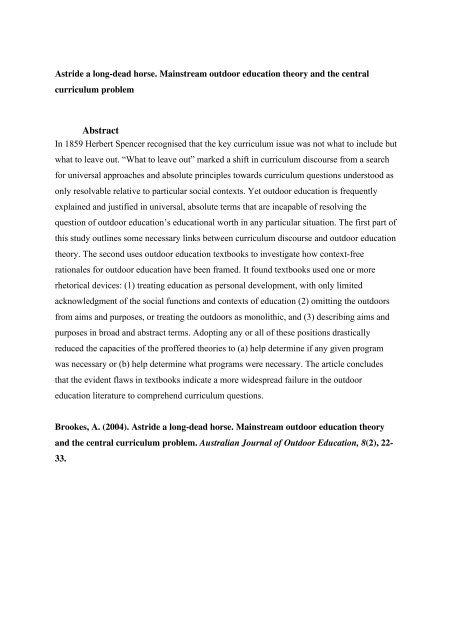
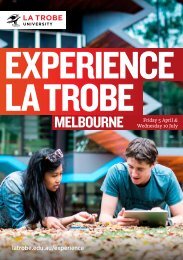
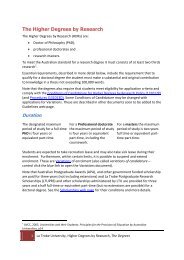
![Ottoman Empire course brochure [PDF 612KB] - La Trobe University](https://img.yumpu.com/12001562/1/184x260/ottoman-empire-course-brochure-pdf-612kb-la-trobe-university.jpg?quality=85)
![Getting Ready to Talk Manual [PDF 315KB] - La Trobe University](https://img.yumpu.com/11430807/1/190x245/getting-ready-to-talk-manual-pdf-315kb-la-trobe-university.jpg?quality=85)

